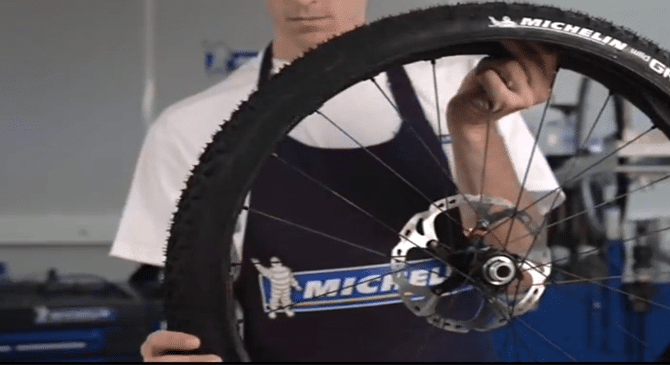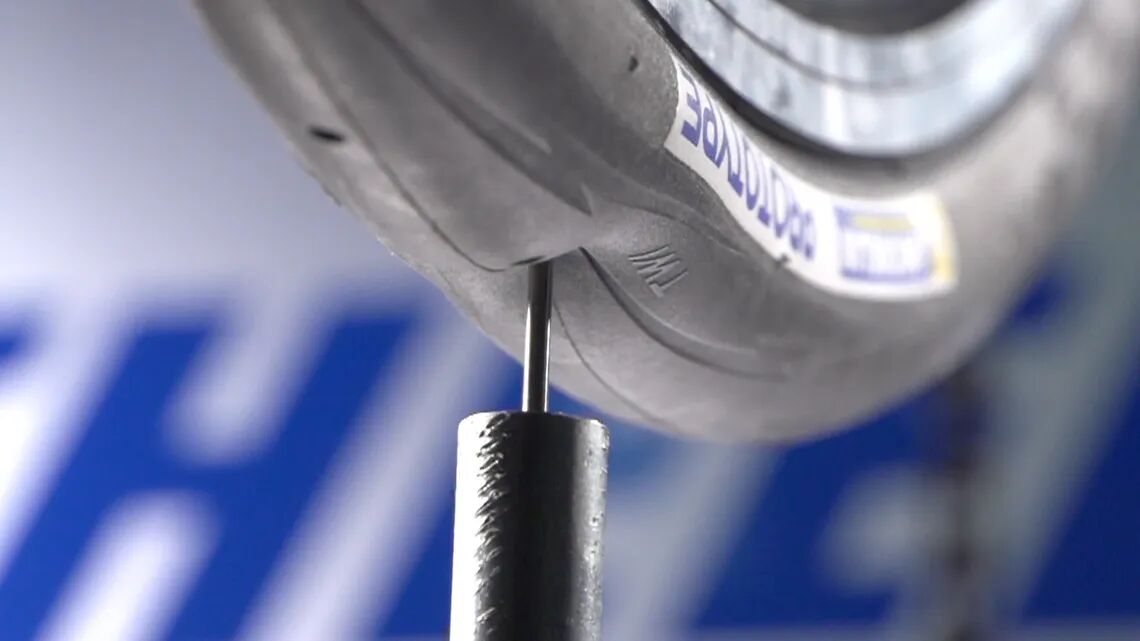What is the recommended bike tyre pressure?
It would be too simple and incorrect to claim that there is a fixed pressure suited to all tyre types, all bicycle types, all riders, and all situations. For example, a moutain bike rider on the heavy side may need more tyre pressure than a much lighter rider cycling on a road bike. And likewise, the recommended tyre pressure for a folding bike may well differ from the recommended tyre pressure for an e-bike.
What is important to understand is that under-inflated bicycle tyres create more rolling resistance and therefore make cycling harder, but it also creates risks of punctures, materials damages or poor handling.
A too high bicycle bike tyre pressure can also cause problems. However, there may be exceptions to these indications, particularly for MTB tyres. As an example, decreasing pressure on very soft terrain like sand and mud could help you to gain some rolling efficiency.
Does this seem confusing? As a start, you can watch our video “How to set your tyre pressures”:
HOW TO SET THE RIGHT TIRE PRESSURE?
The main idea is that there is simply a balance to strike when pumping up bicycle tyres. And to help you with this, MICHELIN provides a range of recommended ture pressures for all tyre models.
Check out the MICHELIN racing road bike tyres, for example. Designed mainly for rolling efficiency, these need different pressures to perform than other tyres, such as those in the city bike range. The key point is that cyclists should ensure their tyre pressures are somewhere within the recommended range before heading out for a ride.
The best way to do this is to invest in a bicycle tyre pump with a pressure gauge. When inflating your tyres, this pump will display the current air pressure either in Bars or PSI (Pounds per Square Inch). MICHELIN has a handy bike tyre pressure chart which allows you to swiftly convert PSI to Bar and vice versa. In addition, our bike tyre pressure chart offers further information on how to fine-tune your pressure according to your personal weight and the kind of cycling activity you are engaged in.
Let's take a closer look at the issue of tyre pressure for different disciplines.
Road bike tyre pressure
Firstly, road bike tyre pressure usually requires the front and rear wheels to be inflated to the same pressure. The only exception to this would be the fitting of two different tyre models, each with a different recommended pressure. The next thing to consider with road bike tyre pressure is the tyre section width and most importantly the weight of the rider. The heavier the rider, the higher the bike's tyre pressure should be.
The usage, the terrain you ride on, and the weather conditions are also parameters taken into account for the ideal pressure. Remember, if required, we advise you to consult the MICHELIN bicycle tyre pressure chart to convert these figures to PSI.
Here is how it works:
First, find the detailed recommended bike tyre pressure for the tyre model fitted to your bike.
Then, look at pressures written on the tyre wall*
MICHELIN recommends pumping the tyre until the tyre bead is properly seated on the rim (without exceeding the maximum pressure on the tyre) and then to let some air out by tapping on the valve until your bicycle tyre pressure gauge shows the tyre inflation level is back within the recommended parameters (without going under the minimum pressure limit). Having done this, you will immediately notice that pedalling becomes easier.
To perform, the tyre must have a correct contact patch on the ground and a correct stiffness on the tyre wall.
If the tyre is too hard and the tyre walls do not move under the weight of the rider, decrease the pressure. It will extend the surface of the contact patch and improve comfort and grip performance.
If the tyre is too soft under the weight of the rider and the tyre wall deforms a lot, or if you often get a flat tyre due to pinch shock (snake bite): increase the pressure, it will improve handling and will prevent against flat tyre.
Mountain bike tyre pressure
The recommended MTB tyre pressure can also be found on the recommended pressure page.
However, this guide is an approximate indication of the final setting as you may need to adjust your mountain bike tyre pressure to suit the terrain. For example, if there are a lot of rough stones on the course, you may need to adapt the tyre pressure.
This is much the same as what is often required for optimal gravel bike tyre pressure where the aim is to avoid punctures.

However, on more forgiving surfaces, the most suitable MTB tyre pressure is likely to be higher, thus creating less rolling resistance and enabling the rider to maintain faster speeds.
Furthermore, as with road bike tyre pressure levels, the weight of the mountain bike rider should also be considered. Heavier riders will tend to force bike tyres to splay out rather more when they're in contact with the ground. Consequently, a greater MTB tyre pressure to will optimise their bike handling and performance.
Note that if you wish to know the MTB tyre pressure adapted to your weight, our pressure page takes this parameter into account to provide you with a recommended value according to your MICHELIN tyre model.
Remember that with mountain bikes, your front wheel should always be set to a slightly lower bike tyre pressure (This recommendation does not apply to other types of bikes).
What bike tyre pressure for other disciplines ?
The MICHELIN tyre pressure tables also give you recommended pressure values for other disciplines such as leisure, enduro and city-trekking.
Tyre TPI explained
TPI stands for “Threads Per Inch”. In precise terms, this means the number of threads in the structure of the tyre’s rubber compound for every inch of its construction. It’s easy to get TPI and PSI confused, but just remember: TPI is related to the density of the tough cords in the tyre's casing – it’s not in any way related to bike tyre pressure. For example, for road use, a tyre with a 120 TPI carcass will be lighter, softer and more mobile than tyres with a lower value, because the threads are thinner, just like the carcass. That's a good thing for cyclists to bear in mind if they are looking for tyres to race on which they will pump up to a high pressure to obtain maximum speeds.
Both cyclists and bike engineers can make slight adjustments to the bike tyre pressure to take account of the TPI rating of the tyres they are using. A slightly higher pressure for a lower TPI tyre may be appropriate for road use, where punctures are less common.
But where a high TPI tyre will be used over rougher terrain, a slight drop in pressure – always within the recommended levels – may help to reduce the risk of a puncture.
However, these concerns tend to mostly affect club cyclists and professionals. They are not something most general cyclists need to worry about, if their bicycle tyre pressure is always within the recommended range.
*MICHELIN doesn’t recommend running the tyre with too low pressure to prevent any flat tire or damage on the rim, and do not recommend exceeding a maximum pressure to prevent any damage during inflation process.


